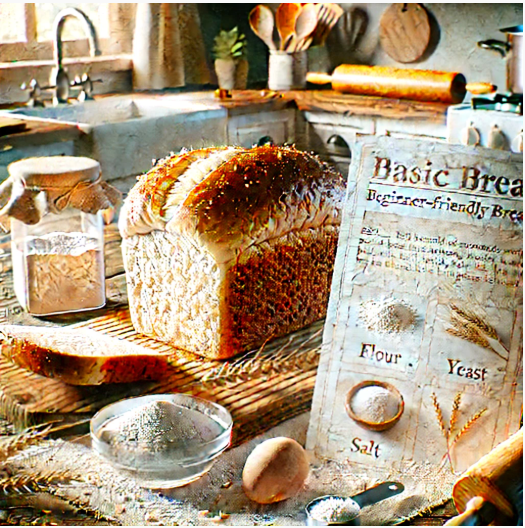Starting your bread-baking journey can feel intimidating, especially with so many styles, techniques, and ingredients out there. But the truth is: you don’t need fancy tools or advanced methods to bake your first amazing loaf. Choosing the right beginner-friendly recipes makes all the difference.
In this article, we’ll help you select simple, foolproof bread recipes to build your skills and confidence—and start enjoying the magic of homemade bread.
- Start with a Basic Yeast Bread
Your first loaf doesn’t need to be artisan-level. In fact, a simple white or whole wheat sandwich bread is the perfect place to start.
Why?
- Few ingredients (flour, water, yeast, salt, sugar, oil)
- No special tools required
- Forgiving dough
- Teaches foundational skills: mixing, kneading, proofing, shaping
Ideal recipe: Classic sandwich loaf or beginner white bread (made in a loaf pan)
- Look for Recipes with Short Ingredient Lists
The simpler the recipe, the more manageable the process. Avoid recipes with lots of mix-ins (nuts, seeds, herbs) or advanced techniques like autolyse or preferments—until you’ve nailed the basics.
Great beginner recipes:
- White sandwich bread
- Honey wheat bread
- No-knead Dutch oven bread
- Simple dinner rolls
- Focus on Recipes That Use Instant or Active Dry Yeast
Natural yeast (sourdough) and preferments are wonderful, but they’re better suited for later. Start with instant yeast or active dry yeast, which are easy to use and predictable.
Tip: Instant yeast can be added directly to flour, while active dry yeast should be dissolved in warm water first.
- Avoid High-Hydration Doughs at First
While airy breads like ciabatta or sourdough look amazing, they use high hydration doughs (lots of water) that are very sticky and hard to handle. As a beginner, go for medium hydration (60–65%), which is easier to knead and shape.
Once you’re comfortable, you can begin experimenting with wetter doughs for more open crumb structures.
- Choose Recipes with Clear, Step-by-Step Instructions
Avoid recipes that assume a lot of prior knowledge. Look for:
- Instructions that include timing and visual cues
- Tips for kneading and shaping
- Baking temperature and internal doneness guidance
Some beginner-friendly recipes even include photos or videos—these are gold when you’re learning.
- Go for One-Rise Recipes if You’re Short on Time
Some recipes skip the second rise, making them faster and simpler. While they might not develop quite as much flavor, they’re a great starting point for new bakers.
Examples:
- No-knead bread
- Quick whole wheat bread
- Basic focaccia
- Avoid Enriched Doughs… For Now
Breads like brioche, challah, or cinnamon rolls use milk, butter, and eggs. These ingredients make for soft, delicious loaves—but they also require more precision and care.
Once you’re confident with basic lean doughs, enriched recipes are a great next step!
- Find Recipes with Tools You Already Own
Some recipes call for proofing baskets, baking stones, or Dutch ovens. While these are great, you can begin with:
- A regular loaf pan or sheet pan
- A bowl and spoon
- Parchment paper
- Kitchen towels and a basic oven thermometer
Make bread first. Upgrade tools later.
- Don’t Worry About Appearance (Yet)
Your first loaves might come out lopsided, too brown, or slightly under-proofed—and that’s okay! Focus on:
- Learning the process
- Recognizing how dough feels
- Understanding rise and bake times
The more you bake, the better your bread will look and taste.
- Sample Beginner Recipes to Try
Here are a few popular, beginner-approved recipes:
- Basic No-Knead Bread (flour, water, yeast, salt—baked in a Dutch oven)
- One-Bowl Sandwich Bread (great for meal prep)
- Simple Whole Wheat Bread (with optional honey)
- Quick Yeast Rolls (done in under 90 minutes)
Starting with simple, reliable recipes is the best way to fall in love with bread baking. As your skills grow, so will your confidence—and soon, you’ll be experimenting with all kinds of styles, from focaccia to sourdough. Just remember: every great baker started with flour, water, and a little yeast. You’ve got this!
